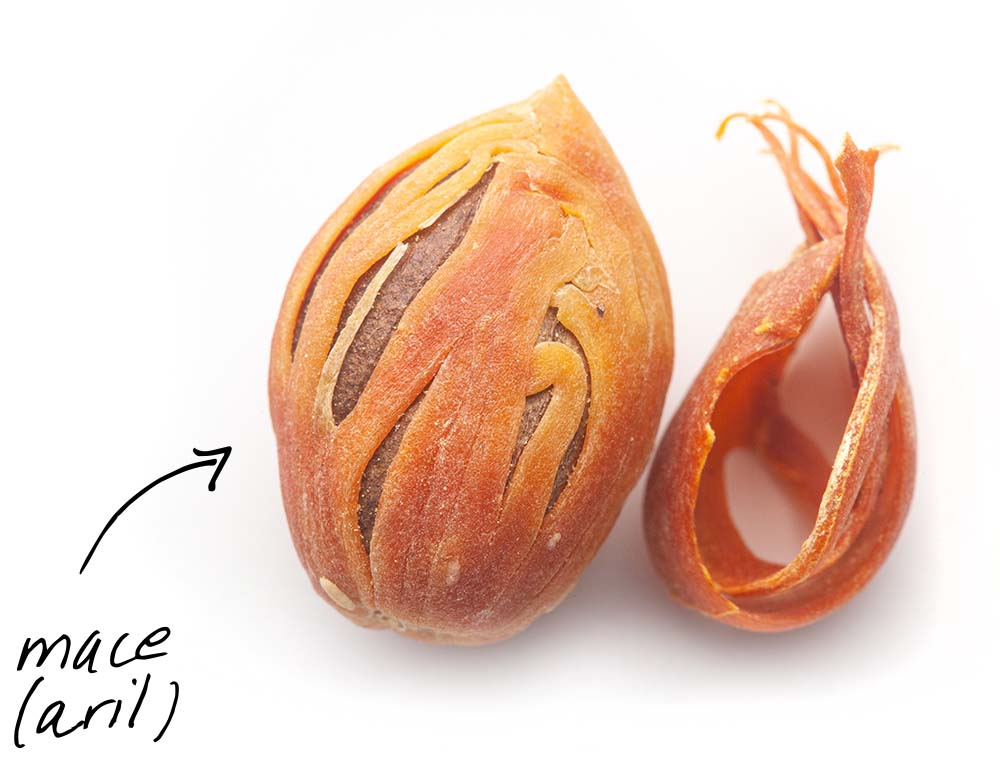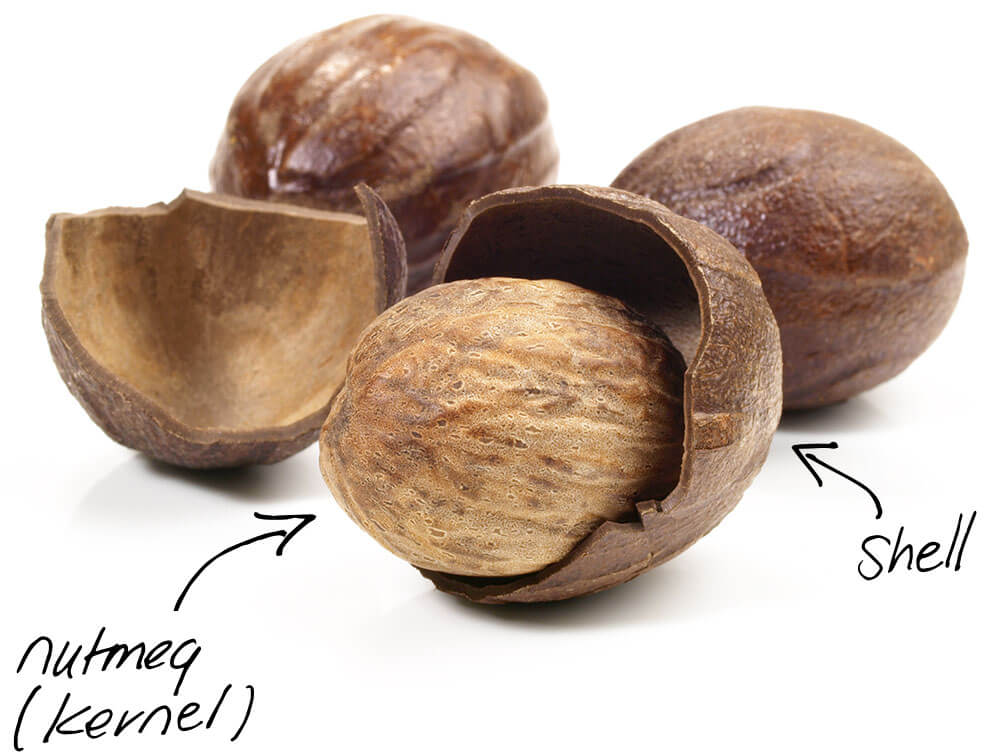featuring
NUTMEG
SELECT BANNER PHOTOGRAPHY BY: KIMBERLY DENNISON
Nutmeg may not be a spice you reach for very frequently. Gracing our pumpkin pies and eggnogs, it's often enjoyed during cooler seasons for its warming flavor. But, you might never guess that control over this modest spice was once exchanged for a small area that is now home to Wall Street: Manhattan, New York City.
Admittedly, there was a time when I also didn't appreciate nutmeg much. It was a spice that sat in the back of my cupboard, most often expired by the time I used it. Eventually, as I learned to cook more European dishes for my German husband, I discovered nutmeg had a special way of adding a touch of “something” to vegetables like potatoes, as well as sauces and egg noodles.

Nutmeg has a deep woody aroma thanks to its main flavor compound, myristicin. It's a crucial flavor element, but nutmeg is also quite complex with floral, fruity, and peppery notes (amongst others).
Native to the Moluccas islands of Indonesia, along with cloves, Nutmeg comes from the fruit of a tropical evergreen tree (Myristica fragrans) that produces two spices: nutmeg, the seed, and mace, its lacy wrapper. Nutmeg is harvested several times a year. The tree can grow up to 40 feet tall and also produces beautifully fragrant flowers.
When a nutmeg fruit is mature, it splits in half revealing a seed covered by a crimson-colored lacy aril—used to make mace. The seed and aril are separated for drying, and the seed is eventually cracked open to retrieve the nutmeg kernel. Kernels are kept whole or ground, although the oils in the ground variety are amongst the quickest of all spices to evaporate.

*This article is by food blogger and Selefina creator Rena Sak (A Girl and a Spoon). At Selefina, we believe that cooking should be about exploring and experimenting with new ingredients. We hope having our creators share what they've learned about a spice will inspire others to go on their own journey.
NUTMEG EXCHANGED FOR NEW YORK
Nutmeg originates from the Banda Islands in the Moluccas archipelago of Indonesia, once known as the Spice Islands. Similar to cloves, this region has an intense and complex history. It was originally traded as part of the Austronesian maritime spice trade network, going back to at least 1500 BC.
Nutmeg found its way westward, to India and later Constantinople, part of the Roman Empire, around the 6th Century AD. For centuries, nutmeg's origin was supposedly kept secret, eventually being discovered by Arab traders. They, however, also maintained its secrecy, being crucial parties to the spice's entry into the West via the Silk Road. By the 16th Century AD, nutmeg was in high demand and was said to be more precious than gold.
When the Ottoman Empire took control of the Silk Road, Europe raced—by boat—to find the location of the Islands, with Portugal discovering them in 1511. By the late 16th Century, the Dutch, as part of the Dutch East India Company, brutally seized control of the Bandas, aiming for the monopoly of nutmeg, mace, and cloves.
The English and the Dutch repeatedly fought for control over nutmeg, particularly for the island of Run, occupying and evicting each other multiple times. In 1664, after the second Anglo-Dutch war, the Treaty of Breda was signed. The Dutch would keep the island of Run (plus Surinam) in exchange for relinquishing New Amsterdam (now known as Lower Manhattan) to the English.
England eventually took temporary control of the Banda islands during the Dutch interregnum after the Napoleonic wars, removing and transplanting nutmeg trees throughout their colonies, notably Sri Lanka and Grenada, where they are still grown. The Dutch retook control until World War II when Indonesia finally obtained independence.
USING NUTMEG
Nutmeg features a sweet, woody flavor, courtesy of its flavor compound, myristicin. It also contains peppery/fruity, floral, and pine-like notes, while also sharing eugenol from clove, its sibling from the Moluccas. These flavors make nutmeg a wonderfully complex spice.
While popular in the United States as a sweet holiday spice giving eggnog its unique flavor, nutmeg may be known more for its savory inclusions in other parts of the world. Jamaican jerk seasoning, the French quatre épices, the North African ras el-hanout, and Indian garam masala all feature nutmeg (or its mace sibling) in their blends. In its home of Indonesia, nutmeg is often used to flavor soups and stews.
TIPS TO GET THE MOST OUT OF NUTMEG
- Nutmeg's flavor oils are short-lived; if you want something more mellow, add it earlier while cooking or baking to soften its easily overpowering flavor
- Inversely, if you do want that punch of flavor, add it towards the end of cooking, ideally grated from a whole kernel
GROUND VS WHOLE NUTMEG
Ground nutmeg is a great option to have if you prefer more mellow flavor, or want to use it in baking or spice blends. As the oils evaporate quickly when processed, it will lose its potency, especially after opening - but, that may be what you prefer.
Whole nutmeg will last much longer (kept in a cool, dark place). Since the oils are retained in the kernel, you'll get the most flavor grating it sparingly towards the end of cooking, or as a dusting on drinks.
GET CREATIVE
- Often used in potato or spinach dishes in Europe, try adding it to any dish that features these vegetables. Grate just a pinch into mashed potatoes, or add to a creamed spinach dip.
- Add it to soups, such as pumpkin or squash; a grating right before serving will also deliver a delight to the nose.
- Add some to your pasta dough; a personal favorite of mine when making German egg noodles.
- Include a generous pinch in ground red meats, such as meatloaf, meatballs, or stuffed fillings for more dimension.
- Sprinkle over desserts like rice pudding, custard tarts (or crème brûlée), or a slice of your standard pumpkin pie to give an extra oomph. A grating on vanilla ice cream is DELICIOUS, and milk-based drinks are a lovely way to infuse nutmeg flavor.
Nutmeg is quite unique, as not many other spices contain myristicin. It pairs well with other strong flavors. Cineole, another of its flavor compounds, is contained in many other spices, making it a great option for varied pairings.
-
To complement nutmeg's...
- Fresh, eucalyptus-like flavors (cineole): pair with cardamom, bay leaf or galangal; cassia and clove will also add warmth
- Woody notes: add anise to enhance the sweetness, as it has a bit of myristicin
- Fruity pepperiness: pair caraway, which will enhance sweet notes, or garlic adding pungency
AVAILABLE
On a personal note: When researching for a Primer, I like to really get into the spices. I will smell, taste whole, crush or - in nutmeg's case - grate, and take time to really experience a spice and its complexities. I was pleasantly surprised when tasting grated nutmeg. I found it refreshing; strong, yes, but with a balancing freshness that lingered. It's a side of nutmeg I never considered leaning into before, but I sure will now! — Rena Sak
